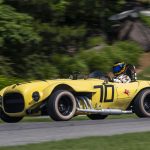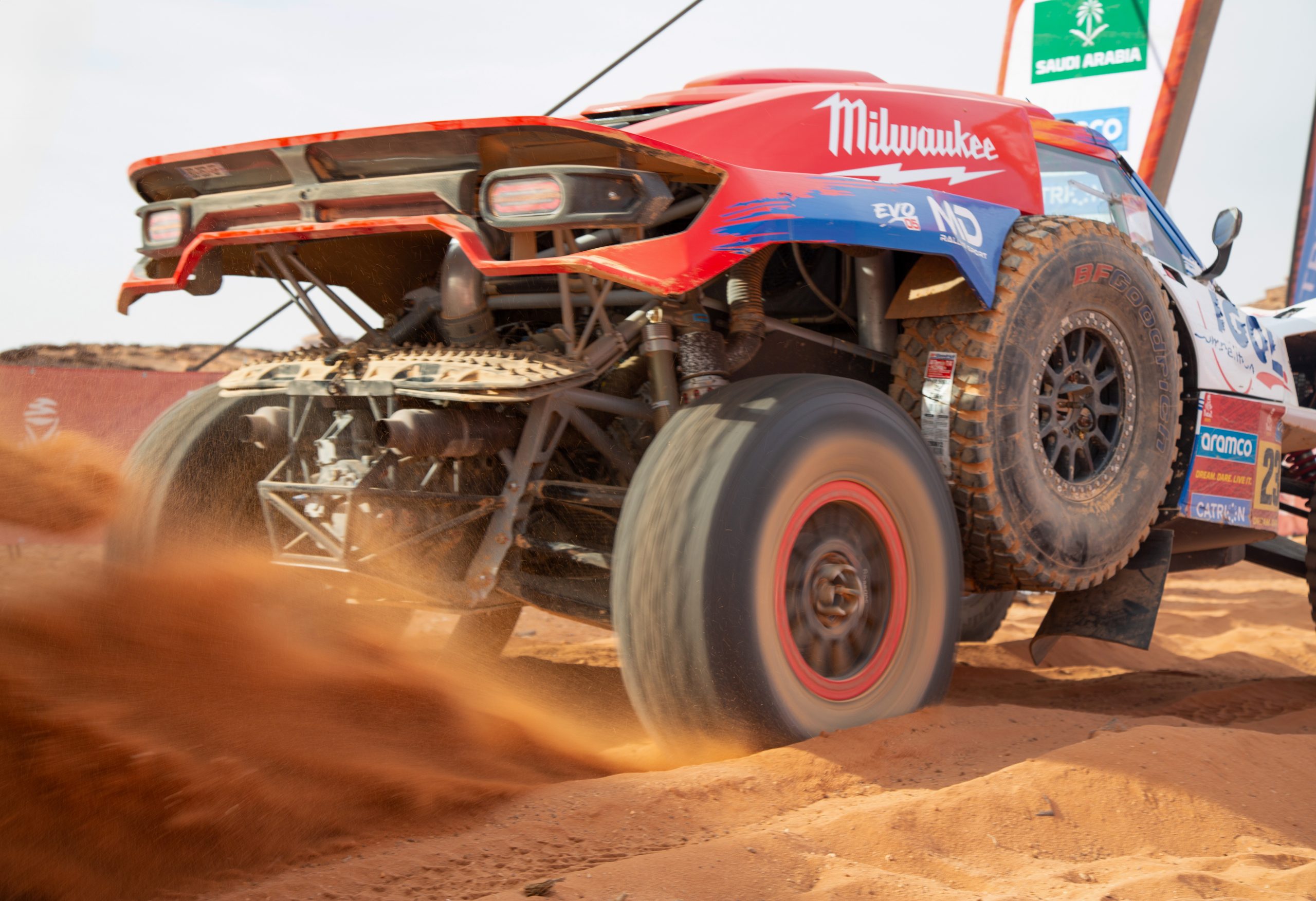Editor’s note: This piece was originally published by our colleagues at Hagerty US, but the stories here are too good not to share with the good people of the UK, and beyond!
Rules are to race car builders as passwords are to hackers: pesky annoyances that are meant to be circumvented. Is that cheating? Only if you get busted. As Darrell Waltrip put it after he and AJ Foyt had their qualifying times for the 1976 Daytona 500 tossed out because they were packing hidden nitrous-oxide bottles: “If you cheat and don’t get caught, you look like a hero. If you cheat and get caught, you look like a dope. Put me where I belong.”

Since the dawn of motorsports, technical inspectors charged with enforcing the rules have been engaged in a never-ending game of whack-a-mole with car builders determined to evade them. To be fair, a lot of straight shooters operate in the grey area between right and wrong – such as Roger Penske, who dominated the Indy 500 in 1994 with pushrod engines that exploited a loophole in the USAC rulebook. But it’s no coincidence that the winner of the first-ever NASCAR race in 1949 was disqualified for using illegal springs optimised for running moonshine.
Progress being what it is, the bad guys have gotten a lot more sophisticated since then. Here’s a top 20 list of the most ingenious cheats of the past half-century.
Ghost in the Machine
Ayrton Senna was the first rival to complain that Michael Schumacher was illegally using traction control in his Benetton B194. After the French Grand Prix in 1994, where Schumacher sliced into a commanding lead from third on the grid, the FIA examined the software in his car’s ECU. Lo and behold, engineers found a subroutine helpfully labelled “launch control.” But since they couldn’t prove that this apparent smoking gun had been fired during a race, the jury declined to convict, and Schumacher went on to win his first world championship.
Hot Seat
After wrecking his Lotus 64 during practice for the Indy 500 in 1969, Mario Andretti was forced to drive his backup car, a Brawner Hawk that habitually ran hot. Although he qualified second, his oil temperature was off the charts, and USAC refused to allow the car to be fitted with an external oil cooler. Cue the Mission: Impossible crew. During an all-nighter, an oil cooler was concealed behind Andretti’s seat. The next afternoon, Andretti’s back was badly blistered – but he didn’t feel a thing until long after winning the race.
Head Fake
When Volvo entered the British Touring Car Championship in 1994 with the 850 estate, nobody could understand how the boxy estate car kept pulling away from the competition on long straights. The car’s secret? The inline five-cylinder engine didn’t have its head on straight – literally. Tom Walkinshaw Racing had cleverly machined a wedge out of the stock head so it sat at an angle on the block, making the inlet port steeper than standard while the exhaust port was shallower. Better breathing helped TWR “find” 65 horsepower.
Virtual Ringer
Pity poor Daniel Abt. Although he was a race winner in the all-electric Formula E series, he was a noob when it came to esports, the playing of virtual sports online. And he was completely out to lunch after Formula E shifted to a virtual, online format in response to the COVID-19 pandemic. Thus, you can imagine how eyebrows shot up when he unexpectedly qualified second and finished third in the mid-season “Stay at Home” race at “Berlin.” Turns out that he’d sneaked in a ringer, secretly handing the controls to pro gamer Lorenz Hoerzing to race for him. Although Abt insisted this switcheroo was a harmless lark, the FIA was not amused. He was disqualified, fined 10,000 euros, and fired by Audi.
Restrictor Plate Special
Ever since restrictor plates were instituted to starve engines of air (and, therefore, power), engine builders have been angling to bypass them. Ford engineers developed a slick solution in their 2003 Focus RS World Rally Championship contender. When excess air passed through the restrictor plate during off- and part-throttle operation, it was routed through a long tube to a titanium tank concealed inside the rear bumper. When the driver buried the throttle, a butterfly valve opened and stored air flowed back to the engine, boosting power by 5 per cent. The system was technically legal, since the spare air had already gone through the restrictor plate. But the FIA decided it was too clever by half, and it was banned after three races.
Brake Check
Necessity is the mother of invention. In 1982, Formula 1 teams using naturally-aspirated Cosworth engines were outgunned by the turbocharged Ferraris and Renaults. At the time, teams were allowed to top up cooling fluids after a race and before weighing by the scrutineers. So Gordon Murray at Brabham and Patrick Head at Williams fitted their cars with large water tanks, ostensibly to cool the brakes – nudge, nudge, wink, wink. The water evaporated almost immediately, allowing the cars to compete underweight before being ballasted after the chequered flag. A Brabham BT49D and Williams FW07C finished first and second in the Brazilian Grand Prix – and both were promptly disqualified.
Repeat Offender
Crew chief Chad Knaus embodies the NASCAR dictum “If you ain’t cheatin’, you ain’t tryin’.” Even as he won seven championships with driver Jimmie Johnson, Knaus was reprimanded for rules infractions on more than a dozen occasions. His craftiest workaround was rigging the track bar adjuster so that rotating the jackscrew caused the rear window of Johnson’s No. 48 Chevy Monte Carlo to rise outward, diverting air from the rear spoiler and maximising top speed during qualifying for the 2006 Daytona 500. Knaus was suspended for four races and fined $25,000. While Knaus watched on TV, Johnson won the race anyway.
Flexi-Flier
Movable aerodynamic aids are a no-no in F1. But in 2010, as Sebastian Vettel was driving to the first of four consecutive world championships, two eagle-eyed journalists noticed that the front wings of his Red Bull RB6 were closer to the road surface on track than they were in the pits. How to explain this mystery? Designer Adrian Newey had come up with a method of laying up carbonfibre so the wing could droop under aerodynamic load while still passing the FIA’s rigidity test. After Red Bull’s outraged (and out-foxed) rivals complained, a more stringent test was instituted in 2013.
Bumper Drafting
Bobby Allison cruised to a 22-second victory in the Daytona 500 in 1982 despite losing the rear bumper of his Buick Regal on Lap 3. Or maybe he won precisely because his notoriously creative (euphemism alert!) crew chief, Gary Nelson, made sure the bumper would fall off. Although Allison denied that the missing bodywork improved aerodynamic performance, he magically ran the last 100 miles on a single tank of fuel without the benefit of a drafting partner. Nelson was later named NASCAR’s chief tech inspector. Talk about putting the fox in charge of the henhouse.
Bottom Line
What’s the best way to hide an aerodynamic aid? Stick it where the sun don’t shine. Exhibit A was the floor of the Ferrari F2007 F1 car. By attaching it to the chassis with a hinge at the rear and two adjustable springs at the front, the flexible floor allowed the car to be set up lower than the competition, making it more efficient aerodynamically. Also, it could be run more aggressively over curbs, allowing drivers to straight-line chicanes. In Australia, the first race of 2007, Kimi Räikkönen qualified on pole and won effortlessly. The aero police at the FIA then devised a new rigidity test that consigned Ferrari’s movable floor to history’s dustbin.
Waste Not, Want Not
OK, this one really gets into the weeds, but that’s where the best cheats usually lurk. At the Indy 500 in 1979, USAC specified that the inside diameter of the wastegate, or the device that regulates the pressure of exhaust gases routed to the turbo’s turbine, had to be 1.470 inches wide. But by using a wider tube and then inserting an obstruction, such as a washer, some teams met the letter of the 1.470-inch law while creating back pressure that allowed them to defeat the pop-off valve and benefit from increased boost pressure. By using this subterfuge, Dick Ferguson, Tom Bigelow, and Steve Krisiloff bumped their way into the field before being found out and disqualified. After a DQ’d team filed suit seeking an injunction, USAC agreed to an unprecedented fifth day of qualifying, and Krisiloff and Bigelow, stripped of their cheat, made the show after all as the 34th and 35th starters.
Pedal Power
In 1997, photographer Darren Heath couldn’t understand why a rear brake disc on the McLaren MP4/12 F1 car was glowing red even as the car accelerated out of corners. He found a clue inside the cockpit when one of the cars retired at the Nürburgring, where he spotted a second brake pedal. What gives? Designer Steve Nichols had realised that giving drivers the ability to independently apply one rear brake enabled them to dial out understeer, helping the car turn more sharply and allowing the team to run less front wing. It took a while to perfect the brake-steer apparatus. But after the new-for-1998 MP4/13 kicked holy butt in the season opener at Australia using effectively a form of four-wheel steering, the system was prohibited, the usual penalty for building a better mousetrap.
Double Agent
Nobody pushes the envelope better than Roger Penske. In 1968, he entered two seemingly identical cars in the 12 Hours of Sebring: a Camaro that had been built for the upcoming Trans-Am season and a stablemate that had been banned the previous year because the body had been dipped in acid to save weight. After running the legal car through Tech, team manager/lead driver Mark Donohue hustled back to the garage, swapped numbers, and got the lightweight cheater approved as well. Then, the team pulled the same trick in reverse so Donohue and Bob Johnson could both qualify in the acid-dipped model. Penske’s Camaros finished 1-2 in class, but Donohue wasn’t sure who was driving which car. “It was even confusing for us to keep track by then,” he wrote in his aptly titled memoir, The Unfair Advantage.
Heavy Water
By 1984, the FIA no longer allowed water to be added to cars after a Formula 1 race to make weight. So Tyrrell, the only non-turbo Cosworth team left standing, dreamed up a hack. During a late-race pit stop, mechanics filled the tank for the engine’s water-injection system with water supplemented with 65kg of lead shot. After Martin Brundle finished a magnificent second in the Detroit Grand Prix, a post-race inspection found traces of hydrocarbons in the water. Tyrrell argued that the unusual form of lead ballast was legal (the rules were indeed ambiguous) but the FIA investigators accused the team of using prohibited fuel additives, and they went ballistic. Tyrrell was banished from the last three races of the year and stripped of its championship points for the season.
No Joke
NASCAR legend Junior Johnson raised chickens, hogs, and cattle on his farm. In his race shop, he cultivated a banana. Technically, it was a Ford Galaxie that NASCAR founder Bill France had asked him to build in 1966 to goose flagging attendance. Johnson showed up at the Dixie 400 in Atlanta with the wildest stock car anybody had ever seen. The nose of the car was steeply raked to reduce drag while the rear end had been raised to generate downforce. Meanwhile, the top had been chopped so radically that driver Fred Lorenzen could barely squeeze through the window. The shape and distinctive Holly Farms Poultry livery inspired onlookers to dub it “The Yellow Banana” or, less charitably, “Junior’s Joke.” Lorenzen was leading when he hit the wall, and Johnson was told to take his Galaxie home – permanently.
Blown Cover

In drag racing, nothing offers more instantaneous bang for the buck than injecting nitrous oxide into an engine. Nitrous is also a cheater’s friend because the delivery systems are simple to plumb and easy to hide. (Drivers have been known to avoid detection by carrying canisters in their racesuits.) Rumours of widespread nitrous use were rampant during the heyday of Pro Stock, but only one team was outed. Technically, you might say the team outed itself. In 1997, shortly before the qualifying session for an NHRA event in Columbus, Ohio, the paddock was rocked by an explosion. A small metallic bottle was found on the pavement, spewing a gas later identified as nitrous oxide. An investigation determined that crew chief Bill Orndorff had cached the canister inside the oil cooler. After driver Jerry Eckman fired up the engine, the oil temperature rose, and the nitrous bottle exploded. Oops!
What Goes Up Must Come Down
For the 1981 Formula 1 season, the FIA set the minimum ride height at 6 centimetres. Gordon Murray reasoned that this figure applied only to scrutineering. So he designed the Brabham BT49C with soft springs and cylinders filled with water and hydraulic fluid at each corner. At speed, downforce pushed fluid from the cylinders through pinhole orifices to a central reservoir, allowing the car to run closer to the ground, thereby increasing aerodynamic efficiency. But on the cool-down lap after the race, fluid seeped back into the cylinder, and the Brabham rose to meet ride-height regulations. To divert attention from his hydropneumatic system, Murray fashioned a dummy aluminium box with nonoperational electric wires. But after Nelson Piquet’s magisterial win in Argentina, other designers cottoned on to Murray’s trick and conjured up ride-height cheats of their own.
One Size Doesn’t Fit All

The rules for the Kelly American Challenge, which ran from 1977 to 1989, based minimum weight on engine size. To determine engine size, a tech inspector measured the displacement of one cylinder and then multiplied it by the number of cylinders. Sounds cut and dried. What could go wrong? Well, in the engine bay of Tommy Riggins’ Chevy Malibu, one cylinder was especially easy to access, so it was used to measure engine size. But at Road Atlanta in 1983, a contrarian tech inspector chose to check a different cylinder and came up with a different displacement number. How? The cylinder that was usually tested was undersized, while the one on the other side of the V was correspondingly oversized. So even though the engine was legal, the car was too light since the minimum-weight calculation was based on the Mini-Me cylinder.
Plategate
Toyota Team Europe came up with an insanely sneaky way to bypass the restrictor plate during the 1995 World Rally Championship season. The hose that connected the air intake to the turbocharger of the Celica GT-Four was fitted with a metal collar. Screwing it into place compressed elastic washers, thereby moving the restrictor plate 5 millimetres away from the turbo. This allowed air to pass around the plate rather than through it. Hello, 50 extra horsepower! But the real genius of the design was that the very act of taking the unit apart to inspect it released the tension on the springs and caused the restrictor plate to snap back into its original, legal position. The fiddle wasn’t discovered until Rally Catalunya, near the end of the season. The FIA stripped Toyota of all points in 1995 and excluded the team from the 1996 championship.
Smokey’s Bandit
You know those wild stories told about the Chevelle that Smokey Yunick didn’t race in the Daytona 500 in 1968? That it was seven-eighths scale? That Yunick drove it back to the Best Damn Garage in Town after leaving the fuel tank with mystified tech inspectors? Bogus, most of them, but it’s still the greatest cheater car in racing history. There was virtually no piece of that Chevelle that Yunick didn’t massage. The chassis was scratch-built, with a Watt’s linkage and faired-in suspension components. The engine was positioned on the centreline of the chassis, as required, but Yunick moved everything else to the left, including the driver. To optimise aerodynamics, he shaved the door handles, channeled the grille, and flattened the roof. Yunick insisted the car didn’t break any rules. But as he wrote in his memoir: “Was this car a ‘cheater,’ Smokey? You’re goddam rite [sic] it was.”
Also read
Freeze Frame: Mercedes’ record-breaking diesel C111
Evel Empire: Knievel’s stranglehold on the Seventies
11 women who made automotive history









